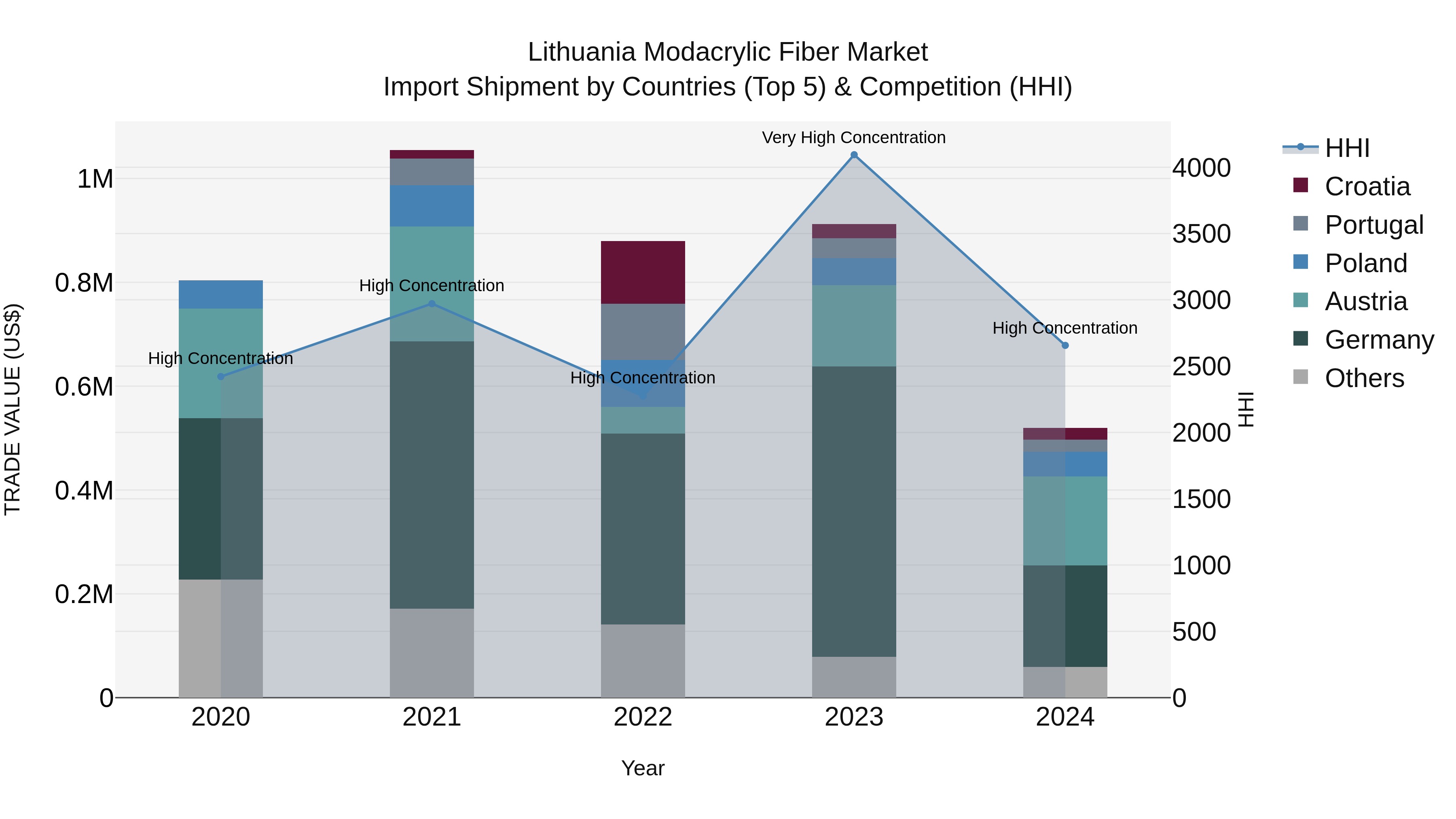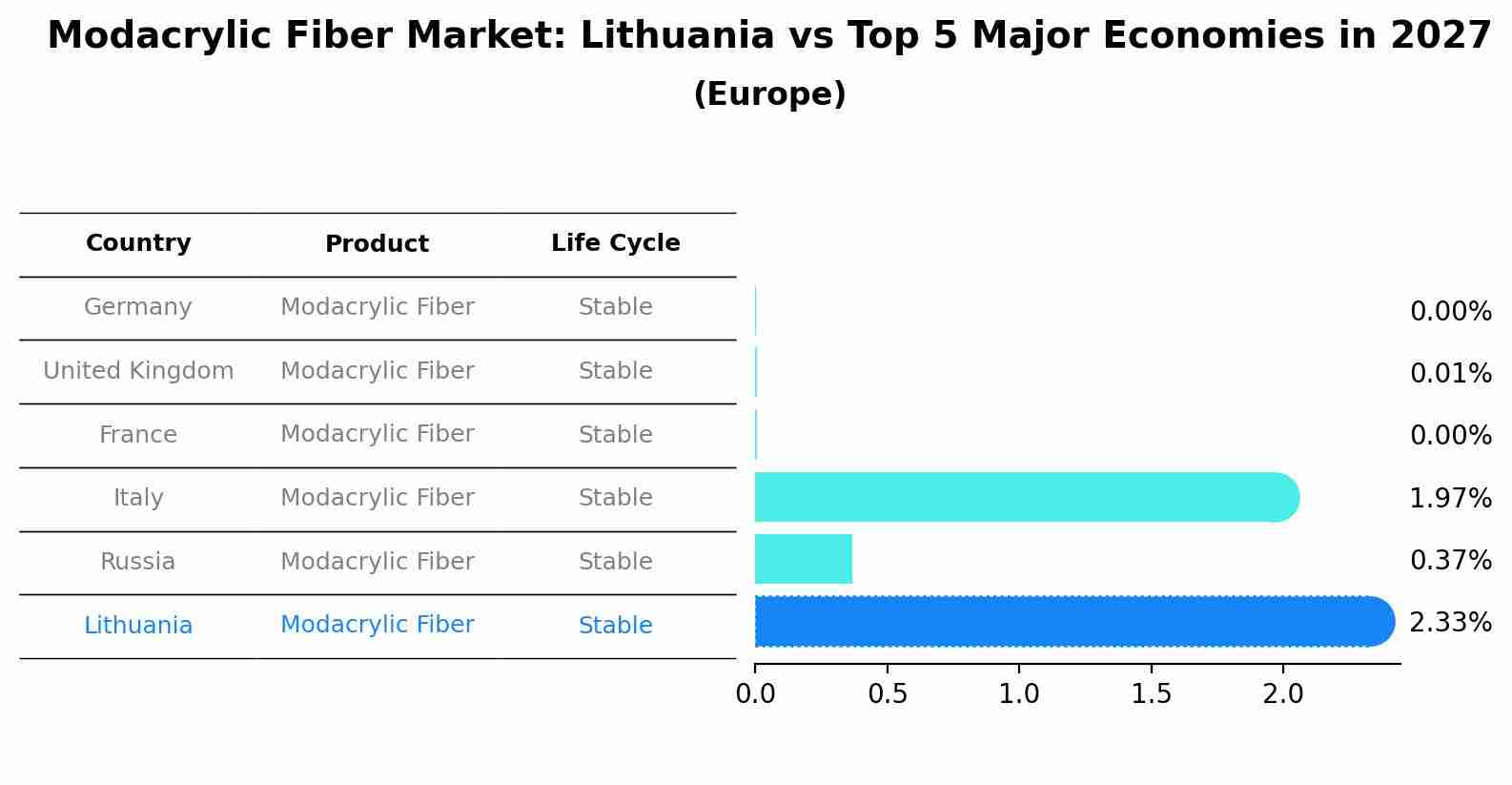Lithuania Modacrylic Fiber Market (2025-2031) | Forecast, Growth, Trends, Industry, Revenue, Segmentation, Companies, Value, Analysis, Size, Share & Outlook
| Product Code: ETC4813861 | Publication Date: Nov 2023 | Updated Date: Nov 2025 | Product Type: Market Research Report | |
| Publisher: 6Wresearch | Author: Shubham Padhi | No. of Pages: 60 | No. of Figures: 30 | No. of Tables: 5 |
Lithuania Modacrylic Fiber Market Top 5 Importing Countries and Market Competition (HHI) Analysis
Despite a decline in growth rate from 2023 to 2024, Lithuania`s import shipments of modacrylic fiber continued to exhibit high concentration, with top exporters being Germany, Austria, Poland, Indonesia, and China. The HHI remained above the threshold for high concentration in 2024, indicating a competitive market dominated by a few key players. The negative CAGR from 2020 to 2024 suggests a challenging market environment, possibly impacted by various factors such as changing consumer preferences or global economic conditions. Monitoring these trends can provide valuable insights for stakeholders in the modacrylic fiber industry.

Modacrylic Fiber Market: Lithuania vs Top 5 Major Economies in 2027 (Europe)
In the Europe region, the Modacrylic Fiber market in Lithuania is projected to expand at a stable growth rate of 2.33% by 2027. The largest economy is Germany, followed by United Kingdom, France, Italy and Russia.

Key Highlights of the Report:
- Lithuania Modacrylic Fiber Market Outlook
- Market Size of Lithuania Modacrylic Fiber Market, 2024
- Forecast of Lithuania Modacrylic Fiber Market, 2031
- Historical Data and Forecast of Lithuania Modacrylic Fiber Revenues & Volume for the Period 2021-2031
- Lithuania Modacrylic Fiber Market Trend Evolution
- Lithuania Modacrylic Fiber Market Drivers and Challenges
- Lithuania Modacrylic Fiber Price Trends
- Lithuania Modacrylic Fiber Porter`s Five Forces
- Lithuania Modacrylic Fiber Industry Life Cycle
- Historical Data and Forecast of Lithuania Modacrylic Fiber Market Revenues & Volume By Applications for the Period 2021-2031
- Historical Data and Forecast of Lithuania Modacrylic Fiber Market Revenues & Volume By Protective Apparel for the Period 2021-2031
- Historical Data and Forecast of Lithuania Modacrylic Fiber Market Revenues & Volume By Hair Fiber for the Period 2021-2031
- Historical Data and Forecast of Lithuania Modacrylic Fiber Market Revenues & Volume By Industrial Fabric for the Period 2021-2031
- Historical Data and Forecast of Lithuania Modacrylic Fiber Market Revenues & Volume By Modacrylic Pile for the Period 2021-2031
- Historical Data and Forecast of Lithuania Modacrylic Fiber Market Revenues & Volume By Upholstery and Household for the Period 2021-2031
- Historical Data and Forecast of Lithuania Modacrylic Fiber Market Revenues & Volume By Other Applications for the Period 2021-2031
- Lithuania Modacrylic Fiber Import Export Trade Statistics
- Market Opportunity Assessment By Applications
- Lithuania Modacrylic Fiber Top Companies Market Share
- Lithuania Modacrylic Fiber Competitive Benchmarking By Technical and Operational Parameters
- Lithuania Modacrylic Fiber Company Profiles
- Lithuania Modacrylic Fiber Key Strategic Recommendations
Frequently Asked Questions About the Market Study (FAQs):
1 Executive Summary |
2 Introduction |
2.1 Key Highlights of the Report |
2.2 Report Description |
2.3 Market Scope & Segmentation |
2.4 Research Methodology |
2.5 Assumptions |
3 Lithuania Modacrylic Fiber Market Overview |
3.1 Lithuania Country Macro Economic Indicators |
3.2 Lithuania Modacrylic Fiber Market Revenues & Volume, 2021 & 2031F |
3.3 Lithuania Modacrylic Fiber Market - Industry Life Cycle |
3.4 Lithuania Modacrylic Fiber Market - Porter's Five Forces |
3.5 Lithuania Modacrylic Fiber Market Revenues & Volume Share, By Applications, 2021 & 2031F |
4 Lithuania Modacrylic Fiber Market Dynamics |
4.1 Impact Analysis |
4.2 Market Drivers |
4.2.1 Increasing demand for flame-retardant and heat-resistant textiles in various industries |
4.2.2 Growing awareness about the benefits of modacrylic fibers such as durability and softness |
4.2.3 Rise in safety regulations and standards across different sectors |
4.3 Market Restraints |
4.3.1 Fluctuating prices of raw materials impacting production costs |
4.3.2 Competition from other synthetic fibers like polyester and nylon |
4.3.3 Limited technological advancements in modacrylic fiber production |
5 Lithuania Modacrylic Fiber Market Trends |
6 Lithuania Modacrylic Fiber Market Segmentations |
6.1 Lithuania Modacrylic Fiber Market, By Applications |
6.1.1 Overview and Analysis |
6.1.2 Lithuania Modacrylic Fiber Market Revenues & Volume, By Protective Apparel, 2021-2031F |
6.1.3 Lithuania Modacrylic Fiber Market Revenues & Volume, By Hair Fiber, 2021-2031F |
6.1.4 Lithuania Modacrylic Fiber Market Revenues & Volume, By Industrial Fabric, 2021-2031F |
6.1.5 Lithuania Modacrylic Fiber Market Revenues & Volume, By Modacrylic Pile, 2021-2031F |
6.1.6 Lithuania Modacrylic Fiber Market Revenues & Volume, By Upholstery and Household, 2021-2031F |
6.1.7 Lithuania Modacrylic Fiber Market Revenues & Volume, By Other Applications, 2021-2031F |
7 Lithuania Modacrylic Fiber Market Import-Export Trade Statistics |
7.1 Lithuania Modacrylic Fiber Market Export to Major Countries |
7.2 Lithuania Modacrylic Fiber Market Imports from Major Countries |
8 Lithuania Modacrylic Fiber Market Key Performance Indicators |
8.1 Percentage of market penetration in key industries (e.g., automotive, protective clothing) |
8.2 Adoption rate of modacrylic fibers in new applications |
8.3 Research and development investment in enhancing modacrylic fiber properties |
8.4 Number of partnerships or collaborations for expanding market reach |
8.5 Customer satisfaction levels and repeat purchase rates |
9 Lithuania Modacrylic Fiber Market - Opportunity Assessment |
9.1 Lithuania Modacrylic Fiber Market Opportunity Assessment, By Applications, 2021 & 2031F |
10 Lithuania Modacrylic Fiber Market - Competitive Landscape |
10.1 Lithuania Modacrylic Fiber Market Revenue Share, By Companies, 2024 |
10.2 Lithuania Modacrylic Fiber Market Competitive Benchmarking, By Operating and Technical Parameters |
11 Company Profiles |
12 Recommendations | 13 Disclaimer |
- Single User License$ 1,995
- Department License$ 2,400
- Site License$ 3,120
- Global License$ 3,795
Search
Thought Leadership and Analyst Meet
Our Clients
Related Reports
- Canada Oil and Gas Market (2026-2032) | Share, Segmentation, Value, Industry, Trends, Forecast, Analysis, Size & Revenue, Growth, Competitive Landscape, Outlook, Companies
- Germany Breakfast Food Market (2026-2032) | Industry, Share, Growth, Size, Companies, Value, Analysis, Revenue, Trends, Forecast & Outlook
- Australia Briquette Market (2025-2031) | Growth, Size, Revenue, Forecast, Analysis, Trends, Value, Share, Industry & Companies
- Vietnam System Integrator Market (2025-2031) | Size, Companies, Analysis, Industry, Value, Forecast, Growth, Trends, Revenue & Share
- ASEAN and Thailand Brain Health Supplements Market (2025-2031) | Strategy, Consumer Insights, Analysis, Investment Trends, Opportunities, Growth, Size, Share, Industry, Revenue, Segments, Value, Segmentation, Supply, Forecast, Restraints, Outlook, Competition, Drivers, Trends, Demand, Pricing Analysis, Competitive, Strategic Insights, Companies, Challenges
- ASEAN Bearings Market (2025-2031) | Strategy, Consumer Insights, Analysis, Investment Trends, Opportunities, Growth, Size, Share, Industry, Revenue, Segments, Value, Segmentation, Supply, Forecast, Restraints, Outlook, Competition, Drivers, Trends, Demand, Pricing Analysis, Competitive, Strategic Insights, Companies, Challenges
- Europe Flooring Market (2025-2031) | Outlook, Share, Industry, Trends, Forecast, Companies, Revenue, Size, Analysis, Growth & Value
- Saudi Arabia Manlift Market (2025-2031) | Outlook, Size, Growth, Trends, Companies, Industry, Revenue, Value, Share, Forecast & Analysis
- Uganda Excavator, Crane, and Wheel Loaders Market (2025-2031) | Strategy, Consumer Insights, Analysis, Investment Trends, Opportunities, Growth, Size, Share, Industry, Revenue, Segments, Value, Segmentation, Supply, Forecast, Restraints, Outlook, Competition, Drivers, Trends, Demand, Pricing Analysis, Competitive, Strategic Insights, Companies, Challenges
- Rwanda Excavator, Crane, and Wheel Loaders Market (2025-2031) | Strategy, Consumer Insights, Analysis, Investment Trends, Opportunities, Growth, Size, Share, Industry, Revenue, Segments, Value, Segmentation, Supply, Forecast, Restraints, Outlook, Competition, Drivers, Trends, Demand, Pricing Analysis, Competitive, Strategic Insights, Companies, Challenges
Industry Events and Analyst Meet
Whitepaper
- Middle East & Africa Commercial Security Market Click here to view more.
- Middle East & Africa Fire Safety Systems & Equipment Market Click here to view more.
- GCC Drone Market Click here to view more.
- Middle East Lighting Fixture Market Click here to view more.
- GCC Physical & Perimeter Security Market Click here to view more.
6WResearch In News
- Doha a strategic location for EV manufacturing hub: IPA Qatar
- Demand for luxury TVs surging in the GCC, says Samsung
- Empowering Growth: The Thriving Journey of Bangladesh’s Cable Industry
- Demand for luxury TVs surging in the GCC, says Samsung
- Video call with a traditional healer? Once unthinkable, it’s now common in South Africa
- Intelligent Buildings To Smooth GCC’s Path To Net Zero


















